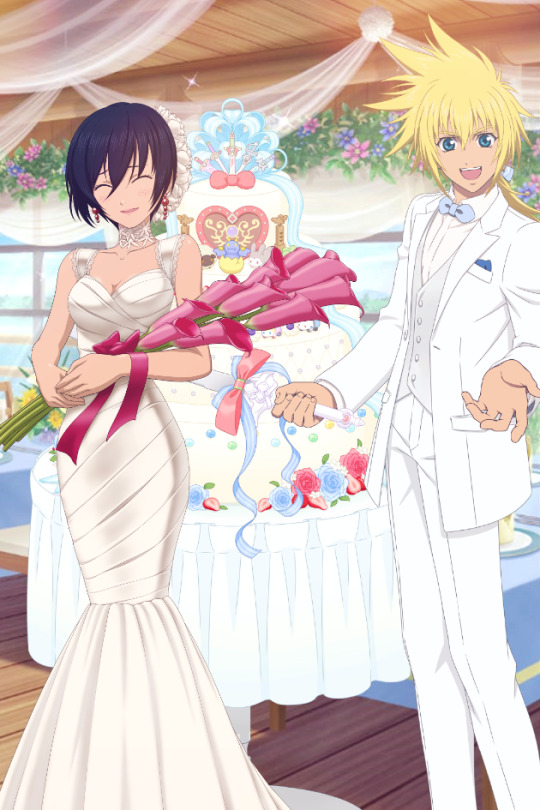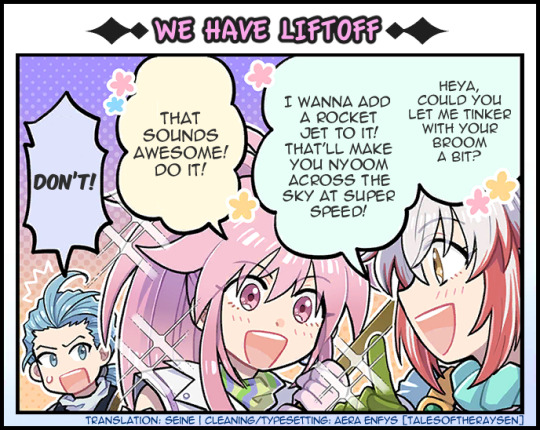#arche klein
Text



Took forever but I wanted to give the older tales games some love >:)
#tales of destiny#tales of vesperia#tales of graces#tales of phantasia#rutee katrea#estellise sidos heurassein#leon magnus#stahn aileron#asbel lhant#sophie lhant#arche klein#suzu fujibayashi#chester burklight#fanart#tales of series
33 notes
·
View notes
Text

her design is so fun to draw!🧹☁️✨
159 notes
·
View notes
Photo


Mint and Arche, Tales of Phantasia
203 notes
·
View notes
Text

#tales of the rays#the rays translation#tales of phantasia#tales of arise#arche klein#chester barklight#alphen (toarise)#t: comic#c: seine#c: aera
71 notes
·
View notes
Text

Today’s Tales of Sunday character goes to Arche Klein from Tales of Phantasia! I wanted to do pink and purple today :3c
#Tales of Sunday!#Tales of Phantasia#Arche Klein#fanart#rough drawing#mewnia’s pawprints#took an hour actually!#doodled her out pretty fast
75 notes
·
View notes
Text

Arche fanart!
137 notes
·
View notes
Photo

Tales of Phantasia (1998)
309 notes
·
View notes
Text

From @fiyr-cap 's suggestion I drew Arche from Tales of Phantasia for pose and composition practice! Luckily I had played most of the game so I'm familiar with her character.
I wound up getting a little lost in her hair near the end of her ponytail, I feel like I wasn't quite sure what to do with it. But picking a pose for being on a broomstick was a little harder than I thought it would be. It was good practice.
#my art#tales of phantasia#arche klein#they also recommended kim from disco Elysium which i have also played that game#i couldn't think of a pose that I immediately wanted to do for him though so I went with arche#some of her references are widly different than others.. especially in how poofy her bangs can be#its like i'm a chick trying to break out of the shell of art and yet i find myself still in the shell hhhgrrr
18 notes
·
View notes
Text



Tales parents + wedding ♡
#tales of phantasia#tales of destiny#tales of graces#seines edit#stahn aileron#rutee katrea#arche klein#chester barklight#asbel lhant#sophie lhant#cheria barnes#you dont know how long i waited for them all to get art#aaaaa
59 notes
·
View notes
Photo








48 notes
·
View notes
Text



Knowledge 27

Meteor Shower Colors - Simple Way To Recognize A Meteor Chemical Composition
Colors of meteors The color of many Leonids is caused by light emitted from metal atoms from the meteoroid (blue, green, and yellow) and light emitted by atoms and molecules of the air (red). The metal atoms emit light much like in our sodium discharge lamps: sodium (Na) atoms give an orange-yellow light, iron (Fe) atoms a yellow light, magnesium (Mg) a blue-green light, ionized calcium (Ca+) atoms may add a violet hue, while molecules of atmospheric nitrogen (N2) and oxygen atoms (O) give a red light. The meteor color depends on whether the metal atom emissions or the air plasma emissions dominate.

Colors of Meteors and Their Chemical Composition. Meteors, commonly referred to as "shooting stars," are fascinating celestial phenomena that have captivated human attention for centuries. These streaks of light in the night sky occur when meteoroids, small rocky or metallic bodies from space, enter Earth's atmosphere and vaporize due to the intense heat generated by atmospheric friction. One of the most intriguing aspects of meteors is their variety of colors, which can range from white and yellow to green, red, and even blue. These colors are not merely aesthetic; they provide valuable information about the composition of the meteoroid and the physical processes occurring during its fiery descent. The colors of meteors are primarily determined by the composition of the meteoroid and the interaction of its material with Earth's atmosphere. Different elements emit characteristic colors when they are vaporized and ionized at high temperatures. For instance: White or Yellow Meteors: These are the most common colors observed in meteors. They typically indicate the presence of sodium, which emits a bright yellow light when heated. Iron, which is prevalent in many meteoroids, can also contribute to a yellowish-white hue when it burns up. Green Meteors: The green color is often associated with the presence of nickel and magnesium. Magnesium, in particular, emits a bright green light when ionized. The green coloration can sometimes be so vivid that it outshines the surrounding colors. Red Meteors: A red hue in meteors is generally less common and can indicate the presence of elements such as oxygen and nitrogen in the Earth's atmosphere, rather than the meteoroid itself. These atmospheric gases emit red light when they are excited by the high temperatures caused by the meteoroid's entry. Blue or Purple Meteors: These colors suggest the presence of elements like calcium and possibly ionized oxygen. Calcium emits blue or violet light under high temperatures. Additionally, the interaction of the meteoroid with the atmospheric gases can also produce these colors. An illustrative image further supports these associations, showing meteors with different colors, each labeled with a specific element: Nitrogen/Oxygen: Red or orange hues, indicating excitation of atmospheric nitrogen and oxygen. Sodium: Bright yellow color, consistent with sodium ionization. Magnesium: Green hue, associated with magnesium. Calcium: Purple or blue colors, representative of calcium. Iron: White or bluish-white light, fitting for iron. The image bellow accurately reflects the scientific understanding that the color of a meteor is indicative of its chemical composition, confirming the role of specific elements in producing particular colors during atmospheric entry. The speed and size of the meteoroid also play crucial roles in the color and brightness of the meteor. Faster meteoroids experience higher frictional heating, which can increase the intensity of the emitted colors. Large meteoroids, due to their greater mass, can produce more prolonged and vivid light displays, often exhibiting multiple colors as different elements within the meteoroid are vaporized at different temperatures. We employ various observational techniques to study meteor colors and compositions. Spectroscopy, for instance, is a powerful method that involves analyzing the light emitted by meteors to identify the characteristic wavelengths of different elements. This technique has helped to confirm the presence of specific metals and gases in meteoroids and the atmosphere, thereby enhancing our understanding of their origins and compositions. The vibrant colors of meteors are not only a spectacular visual experience but also a window into the complex interactions between extraterrestrial materials and our planet's atmosphere. By studying these colors, we can glean insights into the elemental composition of meteoroids, their origins, and the physical processes they undergo during atmospheric entry.
Introduce characters:


#sakuraswordly#tsubasa of phantasia comic#tsubasa of phantasia knowledge#Chester Burklight#Arche Klein#Sonic Crowe#shadow the hedgehog#miles tails prower#sakura tsubasa#Syaoran Tsubasa#Meteor Shower Colors#Technically
4 notes
·
View notes
Text
THE MIXED KID VIDEO GAME BRACKET

16 characters/duos got in!!!
Round 1 goes live tomorrow April 23! 10AM MST
Claude Von Riegen (Fire Emblem) VS. Vex'ahlia & Vax'ildan (Critical Role)
Evan Pettiwhisker Tildrum (Ni No Kuni 2: Revenant Kingdom) VS. Arche Klein (Tales of Phantasia)
Fig Faeth (Dimension 20’s Fantasy High) VS. Yuna (Final Fantasy X)
Faebian Seacaster (Dimension 20’s Fantasy High) VS. Maru (Stardew Valley)
Alice (Virtue’s Last Reward) VS. Trucy Wright (Ace Attorney)
Haruhi & Yuduki (B-Project) VS. Jayce Rogers (Valor Academy)
Alyx Vance (Half-Life) VS. Artemy Burakh (Pathologic)
Chell (Portal) VS. Dante (Devil May Cry)
#mixed matchup tag#tumblr competition#tumblr bracket#game bracket#claude von riegan#vex and vax#vex'ahlia#vax'ildan#vexahlia#vaxildan#evan pettiwhisker tildrum#arche klein#fig faeth#yuna ffx#faebian seacaster#maru sdv#alice vlr#trucy wright#teramitsu haruhi#teramitsu yuduki#jayce rogers#alyx vance#artemy burakh#chell portal#dante dmc#dante devil may cry
33 notes
·
View notes
Text

#tales of the rays#the rays translation#tales of phantasia#tales of graces#chester barklight#arche klein#pascal (tog)#t: comic#c: seine#c: aera
46 notes
·
View notes
Text

Tales girls drawn in 30 seconds
#arche klein#eleanor hume#iria animi#pasca kanonno#cheria barnes#arria ekberg#edna#chloe valens#legretta
7 notes
·
View notes
Text

For @yggdrasil-mith0s
I wish you the best
32 notes
·
View notes
Text

I drew Arche from Tales of Phantasia! She's one of my favorite Tales characters ever- hope you like it!
3 notes
·
View notes